| Page
last updated 12th August 2008 |
|
The
Gallery is in four sections, currently:
Click
on the links to view text descriptions of each section or move straight
to the Gallery pictures.
|
|
Reproduction
Porcelain Dolls
These
are dolls I have made from commercially available moulds mainly
from Byron and Seeleys.
The heads are cast from porcelain slip, (I use Seeleys slip), rubbed
down, and fired to bisque temperatures; they are then painted over
several firings at lower temperatures. The bodies are made usually
from composition slips of various kinds - in the past, I have used
CompoBell (Bells composition slip) which
dries to a pink colour ready for polishing, but now I favour various
papier-maché substitutes, although they have to be painted
once dry.
After
all this there is just the small matter of eyes, wigs, shoes, socks,
underwear, dress and perhaps hat, - and the reproduction is complete.
All reproduction heads are marked by etching the dollmakers name
and date in the greenware before the first firing.
|
 |
|
Reproduction
Doll Gallery click on the picture for details
of each item.
|
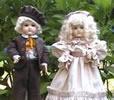 |
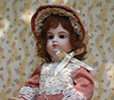 |
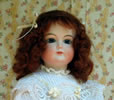 |
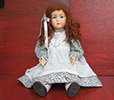 |
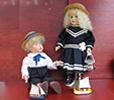 |
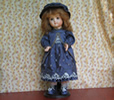 |
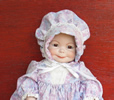 |
|
Petit & Dumontier
|
François Gaultier
|
Kestner XI girl
|
Mein Liebling
|
KR114 sailor pair
|
Steiner Bourgoin
|
Three-faced doll
|
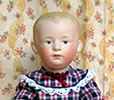 |
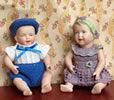 |
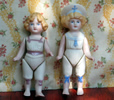 |
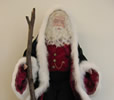 |
 |
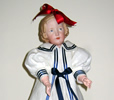 |
|
|
Heubach boy
|
All-bisque babies
|
All-bisque bathers
|
Santa
Claus
|
Simon
& Halbig 1079
|
Heubach Schwester |
|
|
|
 |
|
Rescued
Porcelain Dolls
These
are dolls I have completely reconstructed from porcelain heads
in very poor condition. The heads I use are found usually by people
whose hobby is digging for antique artifacts in places known to
have been the sites of Victorian rubbish dumps.
The
main interest of the treasure hunters is in old bottles and glass;
the doll heads are a by-product in which they have little interest.
There are "bottle fairs" where these collectors sell
and exchange their wares. I made my purchases at the BBR
auction days in Elscar Heritage Centre, (Yorkshire in the UK),
which take place about 4 times a year. Note that I would not recommend
the trip for this purpose alone unless you are local to the area.
The availability and condition of the heads is not consistent.
Basically nothing is left of these dolls except the ceramic blank.
Often the paint has been burnt off or contaminated and there may
be eyes, usually sleep eyes rusted into position. Often the lead
weights for the eyes have melted onto the inside of the head and
I have seen the eyes themselves melted all over the rim of the
eye making he head useless - you can never remove this.
I
believe the glass and bottle collectors have a perception that
French heads are valuable and thus I suspect dispose of them elsewhere.
In consequence I have seen only the normal little German doll
heads by lesser makers, bearing (if marked at all) the more widespread
mould numbers; on thin evidence I estimate that the heads I have
bought date from around 1912. The prices asked for these heads
vary quite a lot; as well as what I consider bargains, many of
the vendors wildly overestimate the value. Many of the heads are
not only badly broken but also quite ugly, with their poor quality
painting and jagged little teeth. However, sometimes a charming
little face shines out at you, and costs no more than its surrounding
ugly duckling sisters.
Once
back at home the heads need a lot of cleaning. I soak them in
biological washing powders, bleach, and also Steradent, or other
product for cleaning false teeth. You can brush them with a soft
tooth brush, but never rub with an abrasive unless it is your
intention to remove all the paint. (Having said this, I now also
use a metal polish intended for cleaning chrome on cars, but you
need to exert extreme care as this is a very fine abrasive paste;
however it also conatins some kind of acid for removing tarnish
and it seems to work well on many of the heads when - as is often
the case - stained with rust marks which are otherwise very hard
to remove). After this if you are lucky you have a clean head
without too many missing paint patches on the face, and you may
have the eyes which cleaned up can be reinserted as stationary
eyes for simplicity.
If
a
head is for any reason "nice" but the paint has mostly
disappeared, you can, for example, make a your own mould from
the head, (resulting in a reproduction doll some 15% smaller than
your original), and perhaps then take the risk of repainting (often
you can follow the lines of the original paintwork, visible as
shadows) and firing. The head may crack - but after all these
are essentially worthless heads which have already endured being
burnt as rubbish, then buried for 100 years. If you don't want
to take that risk you can also repaint with acrylics; this is
a good option too because, if someone in the distant future is
offended by your efforts they can easily remove the paint.
A
final
word on these dolls.
"True" collectors would be appalled at this whole idea.
Any less than perfect doll should be discarded in favour of waiting
for the "perfect" example. However I cannot (or more
precisely do not want to) afford to collect perfect antiques of
any sort. Nor is it my intention to attempt to pass these dolls
off as originals - especially considering the way I reconstruct
them this would be unlikely to fool anyone even unintentionally.
I like to reconstruct these dolls because it is very pleasurable
to be able to see some vision of the little plaything that someone
enjoyed 100 years ago.
|
|
 |
|
| Rescued
and Restored Doll Gallery click on the picture
for details of each item. |
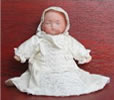 |
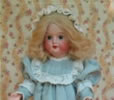 |
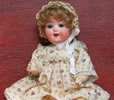 |
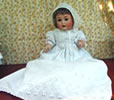 |
|
|
|
| Unmarked German |
Heubach 250 |
Heubach 300 |
German 201 |
|
|
|
|
|
 |
|
Miscellaneous
20th Century Toys
These dolls
and toys I have either had when I was young, given to me as gifts,
acquired by accident, or were too moth-eaten to be left at the mercy
of a sale table. |
|
 |
|
| Miscellaneous
Gallery click on the picture for details of
each item. |
| picture coming soon |
picture coming soon |
picture coming soon |
picture coming soon |
 |
| Nora Wellings Sailor |
Lenci Boy |
All-bisque |
All-bisque sailor body |
|
|
|
 |
|
|
Teddy
Bears
Recently
I took a notion to try making a teddy bear. The result pleased me
a lot, and so I made another. So far I have limited myself to the
book Make your own Classic
Bears by Julia Jones and I have been pleased with the result
of just following the patterns. Currently I am trying to make puppets
for childrens gifts from the Book Bearmaking
101 by Carol-Lynn Rössel Waugh.
Naturally
there are plans for further bears....
|
|
 |
|
| Teddy
Bear Gallery click on the picture for details
of each item. |
|
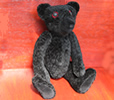
|
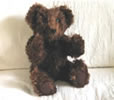
|
|
|
|
| Pre-Teddy German Style |
Early German Style |
|
|
|
|
 |
|























